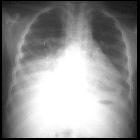Hereditäre Sphärozytose



Hereditary spherocytosis (HS) (also known as Minkowski-Chauffard disease ) is a group of hemolytic anemias due to a genetic abnormality of the erythrocyte cell membrane resulting in spherocytes. The clinical spectrum is broad, from a subclinical state to severe transfusion-dependent anemia.
Epidemiology
- diagnosed in 1 in 2,000 people in N Europe and N America
- 70% inherent in an autosomal dominant manner
- 15% autosomal recessive and 15% sporadic
Clinical presentation
Hereditary spherocytosis may be asymptomatic in many individuals and found incidentally on routine laboratory tests performed for other reasons. In others, the resultant anemia can be severe.
- anemia
- jaundice
- splenomegaly
- positive family history
Complications
- gallstones: from hemolytic anemia
- aplastic crises: especially after B19 viral infection
- extramedullary hematopoiesis
Pathology
Most cases of hereditary spherocytosis are due to defects of the cell membrane of the red cells. These abnormal erythrocytes lose their normal flexibility and are more fragile when passing through the splenic microcirculation, leading to a shorter half-life in the circulation. The cells have a spherical morphology (spherocytes), rather than the normal biconcave discoid shape.
Genetics
The genes most commonly affected are those that code for:
- ankyrin (ANK1)
- band 3 (SLC4A1)
- α spectrin (SPTA1)
- β spectrin (SPTB)
- protein 4.2 (EPB42)
which are all critical protein components of the plasma cell membrane.
Treatment and prognosis
The mainstay of management of this condition historically has been complete splenectomy. Total splenectomy has significant sequelae with regards to patient immunity and unequivocal evidence of reduced overall life expectancy is now recognized. Therefore in recent years, partial splenectomy has come into vogue.
History and etymology
The Prussian endocrinologist Oskar Minkowski (1858-1931) was the first to describe this condition in 1900. He is also remembered as the individual proving that the pancreas was the organ underlying the development of diabetes mellitus .
The French internist Anatole Chauffard (1855-1932) made many important contributions to the understanding of hemolytic anemias .
Siehe auch:
- Splenomegalie
- extramedulläre Hämatopoese
- Sichelzellenanämie
- Thalassämie
- Bürstenschädel
- Gallensteine bei Kindern
- chronisch hämolytische Anämie
und weiter:

 Assoziationen und Differentialdiagnosen zu Hereditäre Sphärozytose:
Assoziationen und Differentialdiagnosen zu Hereditäre Sphärozytose:




